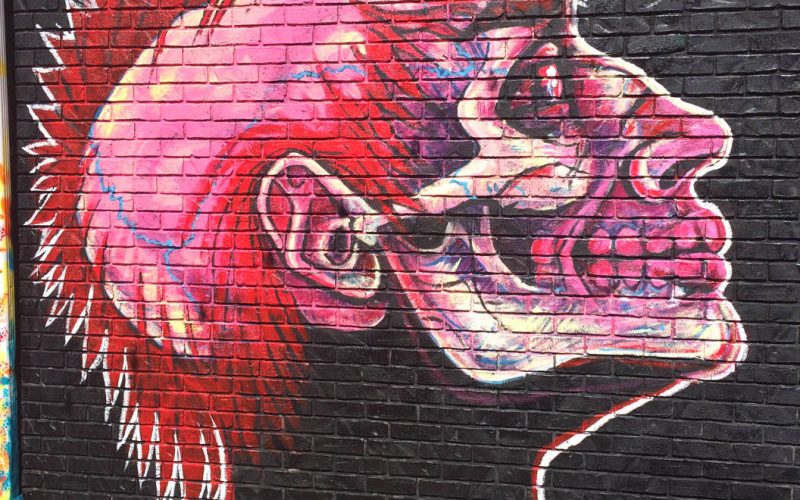
Photos by Jose Lopez Bribiesca
Posing at the Fayetteville Underground are Eric George, from left, Cecilia Hackerson, Emily Hackerson, Octavio Logo and Joseph Fletcher.
What started out as a simple visit to Fayetteville, to spend time with his girlfriend, turned out to become an open door of opportunities for an artist hailing from Mexico City.
On his 36th birthday, June 9, Mexican painter Octavio Logo was close to finishing his first U.S. mural at the Bottle Rocket Gallery, off the Bentonville Square.
He was all too happy to achieve this, reiterating that muralism is one of his favorite art avenues as it allows greater freedom to create a social critique that is wide open to the public.
Before creating his mural, Logo had already shown his paintings in two exhibitions at the Fayetteville Underground, sharing space with other renowned local artists.
Logo’s paintings have erotic and psychedelic elements, with bright red colors accentuating those traits.

Courtesy Photo
Mexican artist Octavio Logo has been working on a mural at the Bottle Rocket Gallery in Downtown Bentonville.
Growing up in the south central part of Mexico’s capital, Logo admits the city’s environment affects his art’s subject matter — he doesn’t paint nature or idyllic scenes, and rather opts for portraits in his own style.
Logo remembers that when he was a boy, his parents admonished him for drawing on walls and all over notebooks — and that’s how he knew he was destined to be an artist.
Besides being a painter, Logo has worked in comic books, but his primary source of income is in bookbinding and restoration of old books, having graduated from the prestigious National Autonomous University of Mexico (UNAM) as an expert in dead languages.
Who is your favorite muralist?
My greatest influence in Mexico is José Clemente Orozco. I think he’s the most complete and most professional painter there, and he has the most varying work. I really like artists who evolve in their type of work, just as Picasso began with realism and then had periods where he suddenly transformed his work into something completely different.
How does Mexico City influence your art?
As a matter of fact, I think the city strongly influences a certain aspect of it, not in a negative sense but in a very aggressive, very violent way. Much of my work speaks about gender violence, inequality, intolerance, and I feel that a lot of my work is reflected in the colors. My palette is very red, very purple, with highly saturated colors.
How does Northwest Arkansas influence you now?

Part of Logo’s exhibition included artwork that would be transitioned into comic book form.
The reception I’ve had is totally different. Even being here [Fayetteville Underground], this gallery belongs to several artists. Normally, the art world is a bit difficult — people compete with each other a lot, there’s too much jealousy. But here I feel the opposite. I feel all the momentum, everyone opens their doors of knowledge, they share their knowledge. It’s something that even influences the way I paint — now it is much more open.



